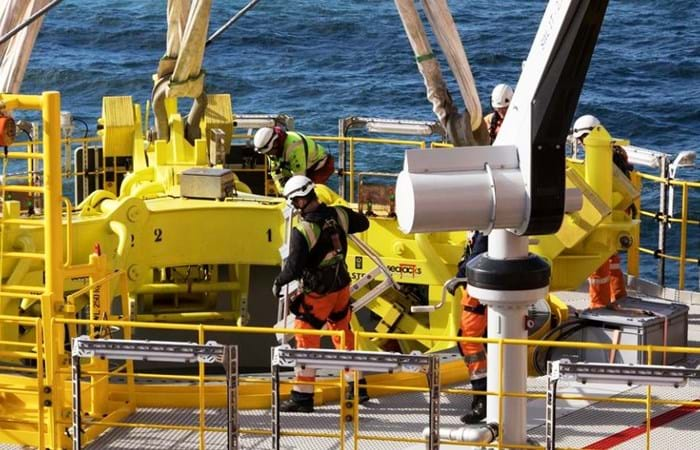Boskalis is close to completing one of its latest and most significant offshore wind projects - Veja Mate, in the German North Sea. The project involves handling and installing the biggest monopiles in the industry – weighing between 1,230-1,302-tonne a piece – using the biggest pile gripper frame and pile driving hammers in the industry with a brand new vessel, which also happens to be the biggest in the sector. Once complete, the offshore wind farm will produce over 1,6 TWh of green, renewable electricity annually.
The wind farm is located in the German North Sea, ~95 km NW from Borkum island in the German Exclusive Economic Zone, an area with strong, steady winds. The water depth is 39 - 41 meters. After first getting involved during the first quarter of 2015, Boskalis was awarded the EPCI contract for design, procurement, fabrication, supply, transportation, installation and testing for 67 wind turbine foundations in the summer of 2015. The project team hit the ground running and encountered challenges: design was already initiated by the client with a design sub-contractor and fabrication was already up and running. Boskalis was also dealing with installation equipment and methods for the 85-meter-tall monopiles the size of which no one had handled before. In addition, everything for transport and installation had to be designed, ordered and built for this project in 10 months.
Pile gripper frame
An extremely focused project team project team put everything on a critical path to ensure that the project stayed on track. Boskalis’ Hydrodynamics engineering department determined the need for a two level pile gripper frame to minimize the impact of the piles swinging when lowering; Boskalis utilized lean planning guidance for the pile gripper fabrication and the installation works were contracted as a package to Seajacks. Construction of the monopiles in Rostock, Germany started soon after contract close. The 350-tonne a piece transition pieces were fabricated in Aalborg, Denmark. From both sites the components were transported to a marshalling yard at Eemshaven, the Netherlands ready for installation.
Monopile installation
A new generation jack-up installation vessel, the SeaJacks Scylla, with a crane that can handle 1,500 tonnes installed the monopiles and the SeaJacks Zaratan transported and installed the transition pieces. Offshore installation involved transporting three monopiles at a time on the Scylla and six transition pieces at a time on Zaratan. Having multiples of three helped to keep the project in sequence. Each pile-driving operation took about 24 hours, including driving through the previously laid scour protection. Scour protection was done using Boskalis’ rock placement vessel the Rockpiper, once unexploded ordnance detection and removal was carried out across the site.
Mitigating underwater noise
Minimizing under water noise on the project was the next challenge. “Mitigating underwater noise comes with strict requirements in Germany and these are the largest piles, at the biggest water depth using the biggest hammer. To be allowed to drive the piles, Boskalis had to prove that the systems kept the noise to an agreed limit. Successful results came after switching contractors and using a hydrosound damper on the gripper frame as well as a double bubble curtain.
Project completion
The project team completed the installation of all the foundations in the fall of 2016. Rasmus Miller, Foundation Package Manager, said “Project work has its ups and downs, but it is never boring. We had our fair share of challenges to overcome and without everyone staying ahead of the game, it was close to impossible to achieve project success. I am therefore extremely proud to say that everyone on our Veja Mate and Boskalis teams, stepped up to the plate and tackled our challenges head-on.” The next steps in the construction of the wind farm will be to complete the energization of the Offshore Substation, the installation of the inter array cables and subsequently the wind turbines. The project is expected to be fully operational by the end of 2017.

